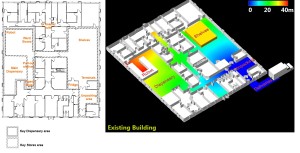Using Evidence-Based Design to Improve Pharmacy Department Efficiency
The Engineering Doctorate is very similar to an ordinary PhD in that we produce and publish academic papers in conferences and journals. The process of peer review helps ensure novelty and impact in new knowledge and keeps academic output to a high standard (in most cases).
As part of my EngD, I have been lucky enough to have my first paper accepted to be published in the Health Environments Research and Design journal. The paper looks at the case study of a Pharmacy redesign project that I worked on with the Smart Space team in BuroHappold alongside my industrial supervisor and the team. The study showed that using evidence based designs, rather than anecdotal designs on what people perceive to be happening, can produce more efficient and effective designs. The abstract, and link for where the paper is available, is provided below.
Abstract
Using a case study of a pharmacy department rebuild in the South West of England, this article examines the use of evidence-based design to improve the efficiency and staff well-being with a new design. This article compares three designs, the current design, an anecdotal design, and an evidence-based design, to identify how evidence-based design can improve efficiency and staff well-being by reducing walking time and distance. Data were collected from the existing building and used to measure the efficiency of the department in its current state. These data were then mapped onto an anecdotal design, produced by architects from interviews and workshops with the end users, and an evidence-based design, produced by highlighting functions with high adjacencies. This changed the view on the working processes within the department, shifting away from a focus on the existing robotic dispensing system. Using evidence-based design was found to decrease the walking time and distance for staff by 24%, as opposed to the anecdotal design, which increased these parameters by 9%, and is predicted to save the department 248 min across 2 days in staff time spent walking.
Keywords
- Evidence based design
- Staff efficiency
- Pharmacy design
- People flow
- People tracking
- People-centred design
Authors
- Fraser Greenroyd
- Dr. Rebecca Hayward
- Prof. Andrew Price
- Dr. Peter Demian
- Dr. Shrikant Sharma
Link for paper download
Using Evidence-Based Design to Improve Pharmacy Department Efficiency paper



